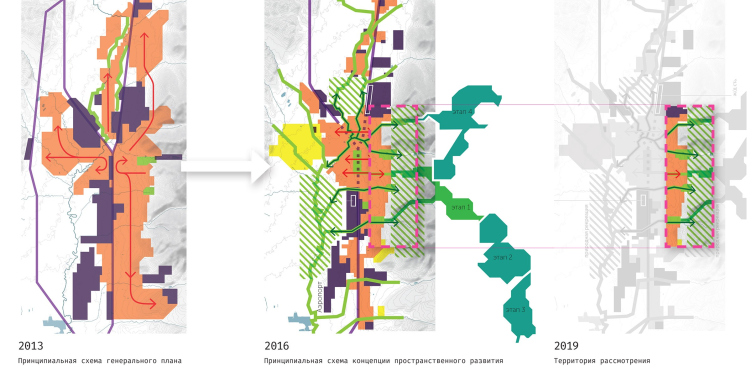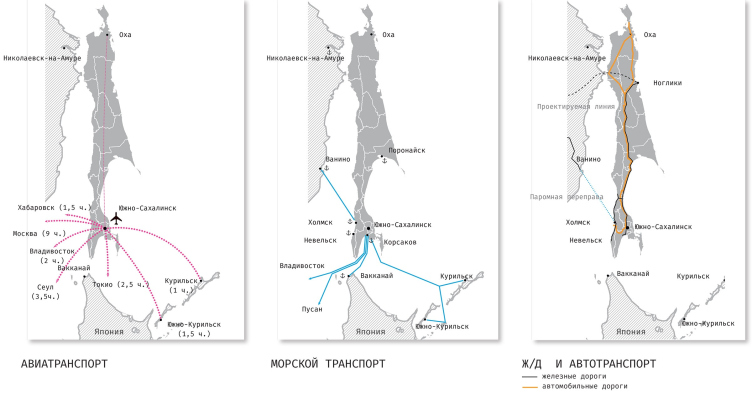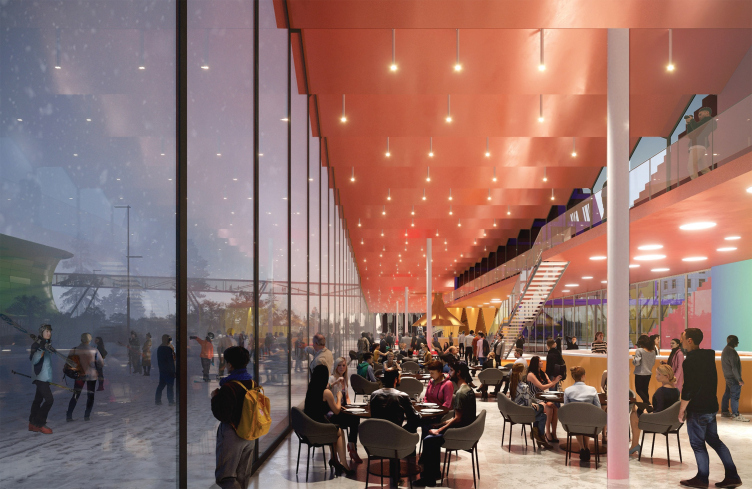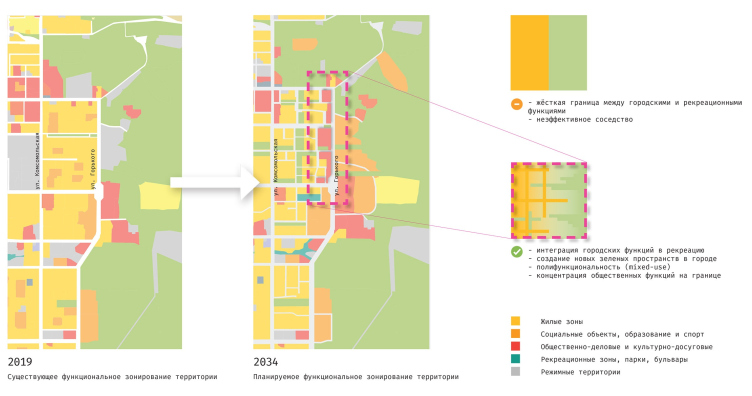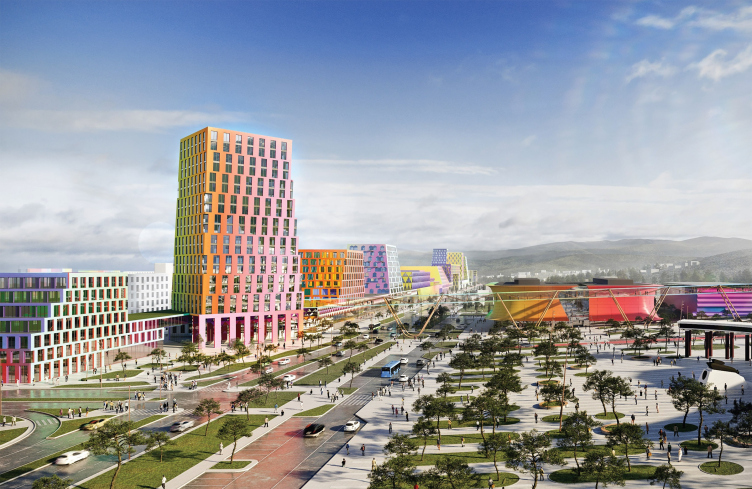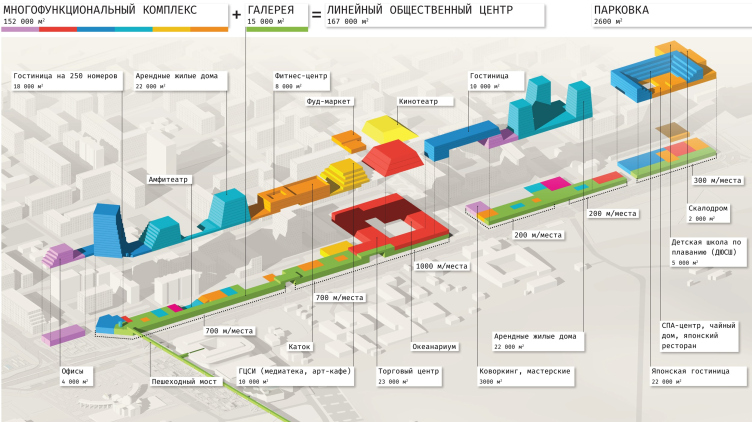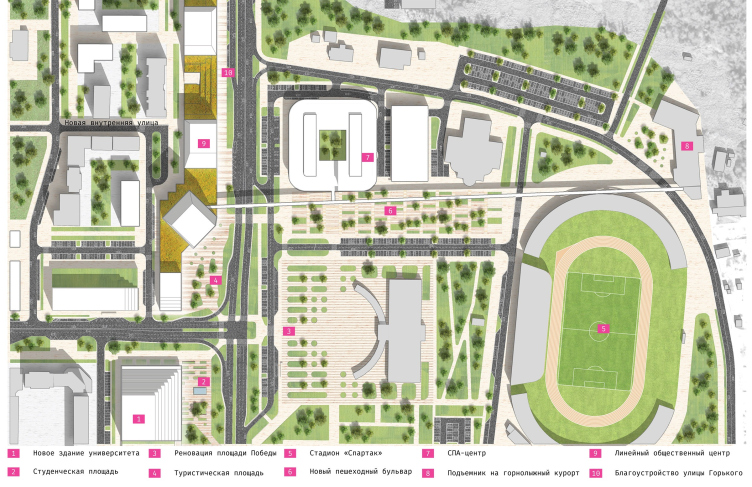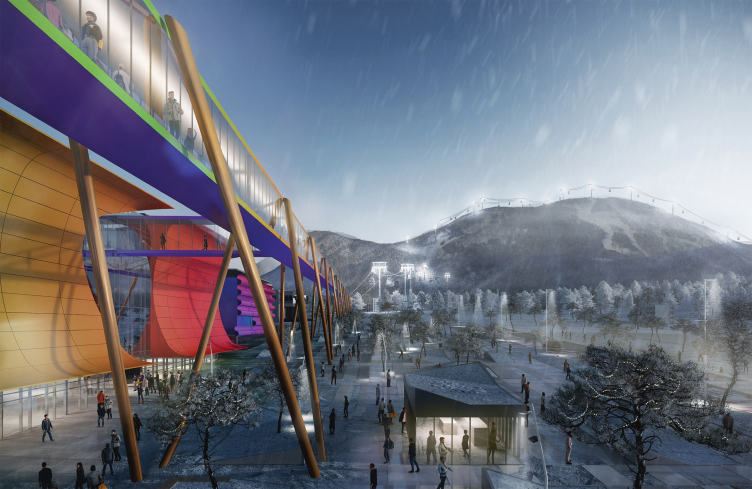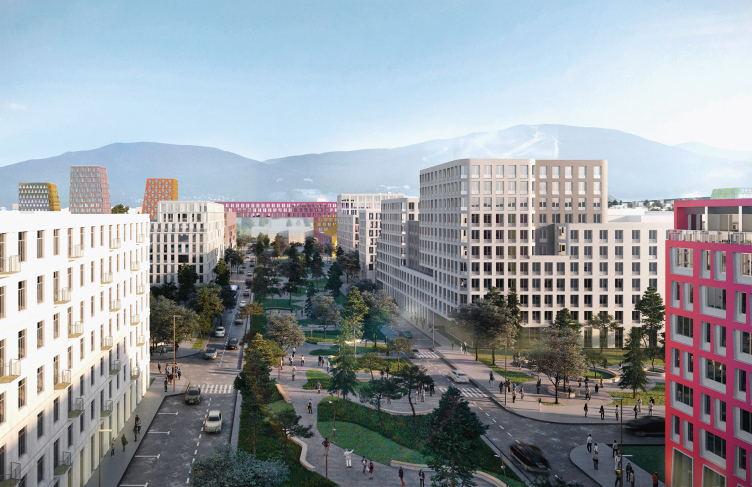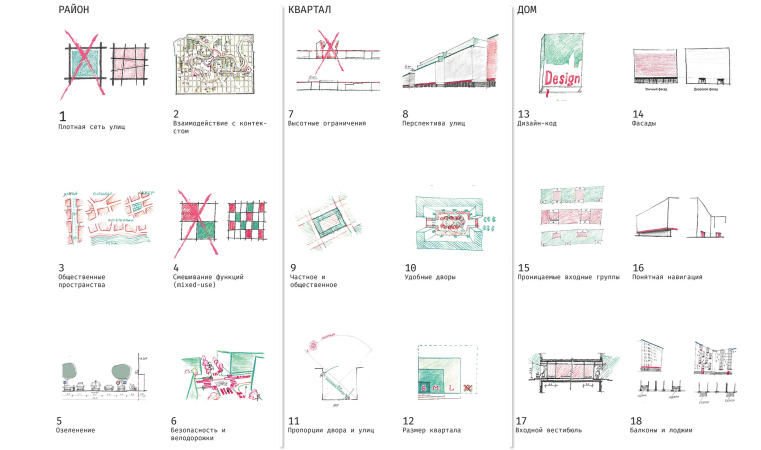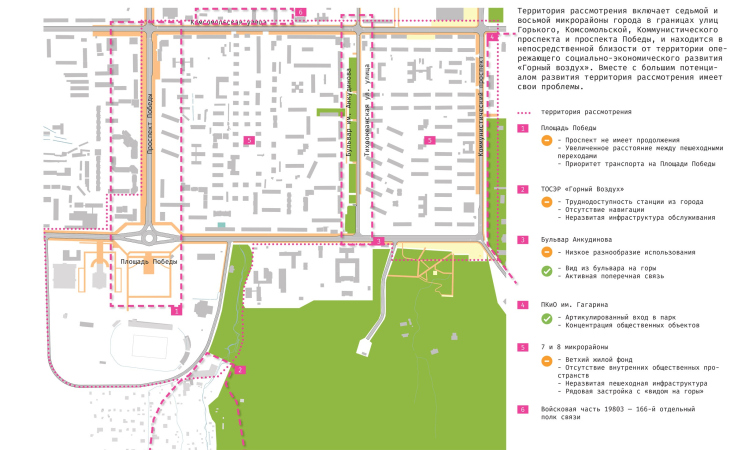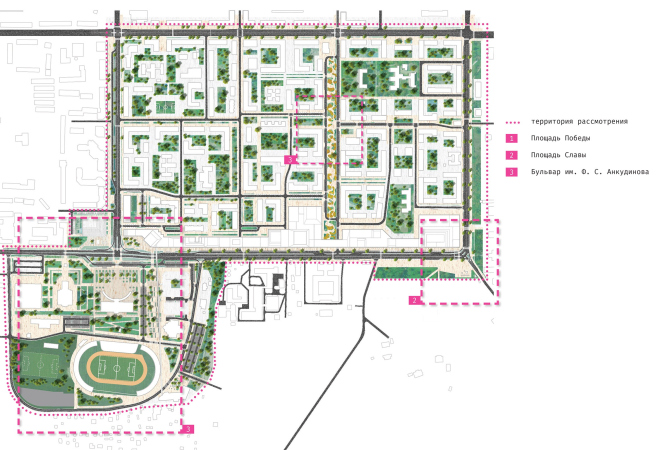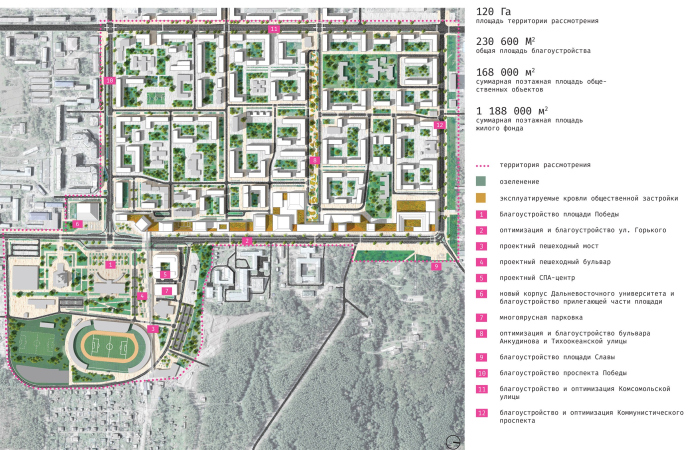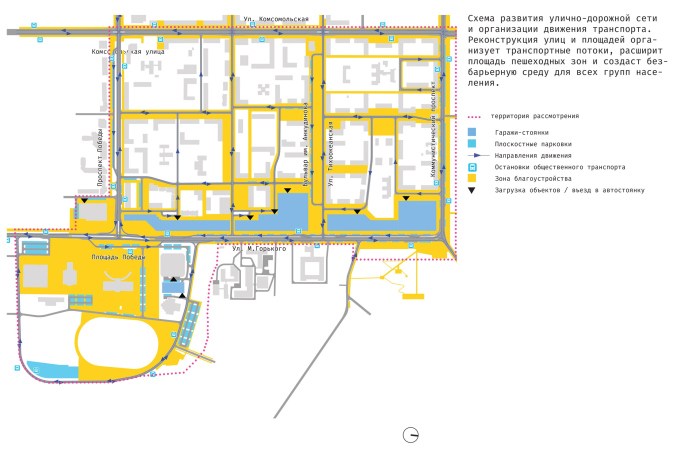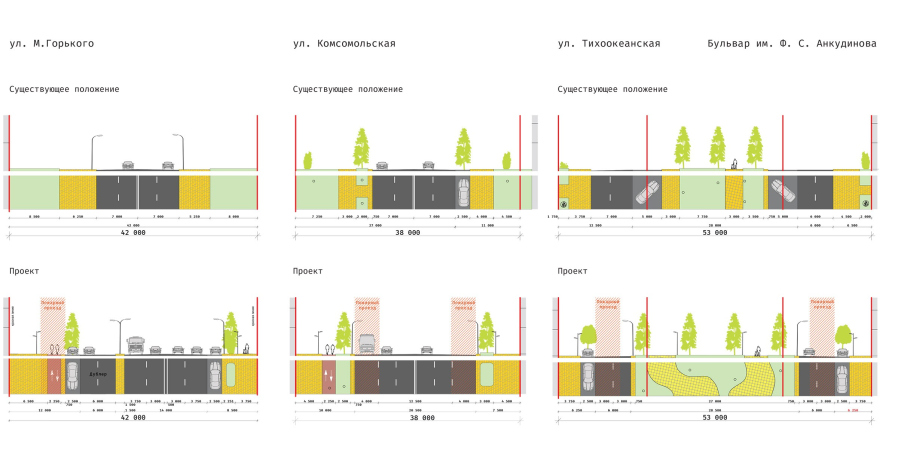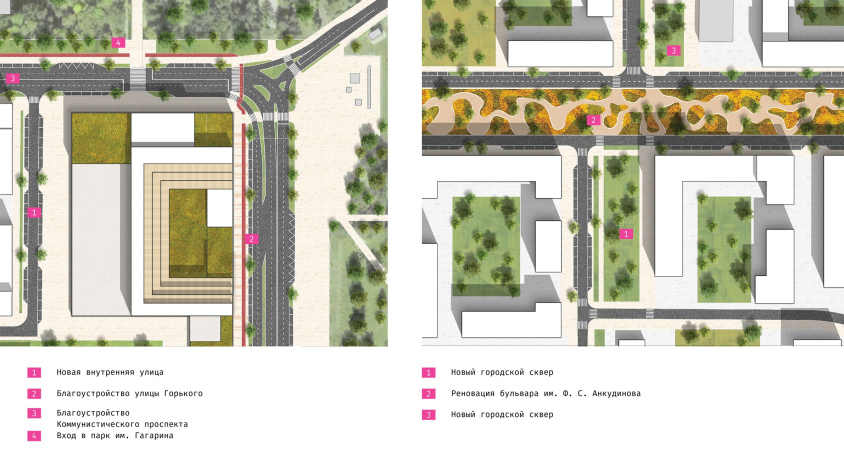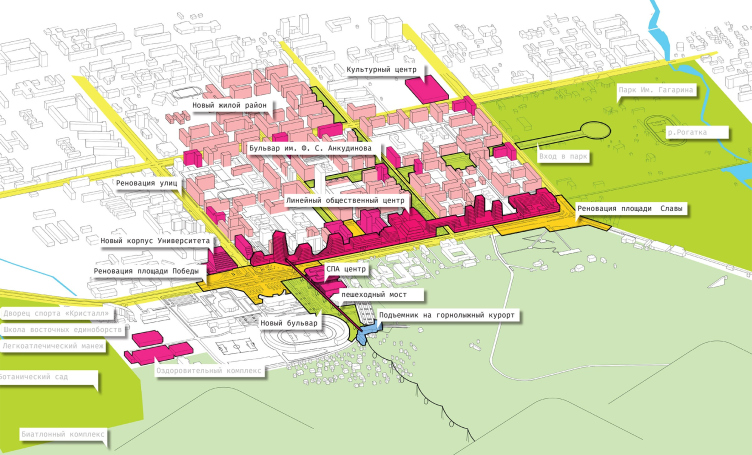Speaking about this project, which won this year’s architectural competition, we cannot avoid covering its background. First of all, in the recent years, the city of Yuzhno-Sakhalinsk, the largest city of the Sakhalin Peninsula, and the capital of the region bearing the same name, has been rapidly developing. Essentially, this has to do with the local budget’s tax revenues from the oil mining in the offshore fields. The Ostozhenka architects began designing for Yuzhno-Sakhalinsk in 2015; they were invited to work on the site plans of several districts of the city, including the central ones, number seven and eight. Shortly, during the process of land survey and the architects’ interaction with the city authorities, it turned out that the city was in a dire need of spatial development, one that would define the general development strategy. In 2016, a competition for such plan was conducted and won by the project submitted by Ostozhenka.
Essentially, the concept, adopted by the city government, is about “changing the city plan from linear to a compact one”. In other words, the architects are proposing to restore, in the center of the existing city, the densely packed orthogonal grid of the Japanese city of Toyohara that was partially dissolved in the large-scale “micro-district” construction. The streets must run closer to one another, the city must become more transparent, and a division into yards and public spaces must appear – these are the “new old” urbanist values that the plan is based upon. The “stitch” micro-district construction is giving way to urban blocks. From my personal viewpoint, such an approach, by no means based on imposing new values, but based on searching for the positive points in the historical development of the location, is generally characteristic of Ostozhenka, which has been kind of their thing since the 1990’s, and today in Yuzhno-Sakhalinsk they are bringing back to light the grid of the old city just as once they would search for the borders of the pre-Revolutuon estates on Moscow’s Ostozhenka Street, trying to give this area a reasonably dense parceling.
The concept of architectural and town planning development of the city of Yuzhno-Sakhalinsk.
Copyright: Ostozhenka Bureau
The geographic location. The external and internal transportation links. The concept of architectural and town planning development of the city of Yuzhno-Sakhalinsk.
Copyright: Ostozhenka Bureau
Other important initiatives include: removing the industrial parks from the railway station area, and creating in their stead the central city park that must join the western and the eastern parts of the city, instead of separating them, which is currently what the industrial parks are doing (by the way, recently an online platform was launched for collecting the Yuzhno-Sakhalinsk residents’ feedback about the development of the city’s public areas).
The Ostozhenka architects also suggested that more attention should be paid to the rivers that flow down from the mountains and into the Susui valley occupied by the city, in order to create linear parks alongside these rivers, which will make it possible to open up better views on the surrounding mountains, breathtakingly beautiful.
Among other things, the concept provides for giving Yuzhno-Sakhalinsk, a city that currently looks painfully monotonous, a unique facade consisting of new designer buildings, predominantly on the eastern side of the city, where the “Gorny Vozdukh” (“Mountain Air”) ski resort is situated, consisting of a multitude of slopes of various degrees of complexity, already popular with both local and Japanese skiers, included in the top ten of Russia’s mountain resorts. The mountains are higher in this side, and they step up closer to the city, so the chairlifts and cable cars start off right from this point.
Districts 7 and 8
The new project, which won in the competition in the spring of 2019, is devoted to Districts 7 and 8, situated near the bottom ends of the “Gorny Vozdukh” chairlifts, on the east border of Yuzhno-Sakhalinsk, yet at the same time close to the city center, a half-hour’s walk away from the city council and the railway station. The districts are built in the style of the 1960’s, and occupy two rectangles, 23 and 37 hectares respectively; they have virtually no inner streets inside of them, only driveways, with a large number of dead ends. The houses are the panel prefabricated type; in the center of District 8, there are a few two-storied wooden ones. To the north of the border of District 7, a large city park begins. To the east, there is a natural territory leading up to the mountains, which serves therapeutic, sporty, and memorial functions, all rolled into one. The residential area is delineated by the Gorky Street, which connects the Ploshchad Pobedy (“Victory Square”), before which the Museum of the Great Patriotic War was built in 2017, to the Ploshchad Slavy (“Fame Square”) with the inevitable Eternal Flame and memorials. There are also a few sports complexes and a stadium here, situated right before the bottom end of the cable car; a little more to the south, there is the Temple of the Birth of Christ, built here in 2016.
The concept of architectural and town planning development of the city of Yuzhno-Sakhalinsk. The existing points of attraction
Copyright: Ostozhenka Bureau
However diverse, these are still pinpoint inclusions, while the Ostozhenka concept provides for all-round transformation of the district that implied the appearance of new landmarks and a considerable increase in the coherency of the space that looks odds and ends now.
The linear center: a multifunctional “backbone”
The brightest and the most intense part of the project is the “Linear City Center”. It consists of a number of buildings of diverse architecture, strung in their lower tiers on the axis of the retail and restaurants public gallery with glass walls, commanding the mountain views, and an operated green roof. Here, in addition to the Gorky Street, a city promenade appears that combines the “warm” space behind the glass wall, and the “cold”, yet still landscaped, space in front of it; these two will be connected not just visually but also with numerous entrances and exits. Currently, the housing space of the micro-districts and the “wild” space of the foot of the mountain are separated by an automobile street – and the authors of the project do everything to overcome this separation, to merge the two parts, the city’s “inside” and the “outside” one: adding pedestrian overpasses, improving the sidewalks, and, finally, opening up the views of the mountains from the glass-protected public space.
The public gallery running along the Gorky Street. The concept of architectural and town planning development of the city of Yuzhno-Sakhalinsk.
Copyright: Ostozhenka Bureau
The prerequisites of creating the tourist cluster. The concept of architectural and town planning development of the city of Yuzhno-Sakhalinsk.
Copyright: Ostozhenka Bureau
Actually, the Linear Center is presented as an embodiment of the idea of a new “city facade”: its silhouette looks like a jagged line of mountain pills, or like an imaginary city, in which the towers neighbor on elongated low-rise horizontal bridges; the highlight of this composition is the bridge above the Ankudinov Avenue that separates the micro-districts. In the project, it looks like some visual sum of the city and the mountains, something bright, attractive, and modern; the prevailing pink hue puts one in the mind of anime cartoons and the Far East sushi. We will emphasize here that the proposed image is not intended for direct application – and the authors of the project say as much – it is just an illustration of the idea of architecture that is bright, new, and dramatic silhouette-wise. Afterwards, Andrey Gnezdilov says, there will be competitions for the best designer architecture projects.
The concept of architectural and town planning development of the city of Yuzhno-Sakhalinsk. View of the Victory Square and the Gorky Street
Copyright: Ostozhenka Bureau
An important feature of this string of buildings is its functional diversity: the architects thought it out in a rather detailed and elegant way, but they are still emphasizing that the lineup of functions may change as the project develops further; what is important is maintaining the multifunctional principle. There are no full-fledged homes around here, but there are hotels and apartment complexes. The offices are situated next to a fitness center and a shopping mall with an aquarium, which are also strung on the stretched-out promenade. There are also other, more modern and more subtle elements of urban life: for example, a branch of the State Center for Modern Art with a hybrid library, a food market, an amphitheater, a co-working space and workshops, a children’s swimming school, and a rock climbing wall.
The linear public center: the functional program. The concept of architectural and town planning development of the city of Yuzhno-Sakhalinsk. View of the Gorky Street as seen from the pedestrian bridge.
Copyright: Ostozhenka Bureau
In the northern part of the line, closer to the park, the authors are proposing to place a Japanese center with a hotel and a SPA center: homage to the nearest neighbor and the guests from this country. In other words, the architects densely packed various functions in this place, the functions that are otherwise packed in different blocks in other cities’ centers. This is meant to make the place more eventful and dynamic, not so much a border as a “backbone” between the residential area and “Gorny Vozdukh”.
The Japanese complex as part of the Linear Center. The concept of architectural and town planning development of the city of Yuzhno-Sakhalinsk. View of the intersection of the Gorky Street and the Kommunistichesky Avenue as seen from the entrance to the
Copyright: Ostozhenka Bureau
In its southern part, the Linear Center slightly spills out beyond the confines of District 8: it is planned to build here a branch of the Far East University with a library accessible to the general public, and a university plaza. Before the hotel, there will be yet another plaza, both of these two making an ensemble with the Victory Square, which currently serves as a very large roundabout, and must become more pedestrian-friendly, providing a link between the city and yet another landscaped plaza before the Great Patriotic War Museum.
The concept of architectural and town planning development of the city of Yuzhno-Sakhalinsk. Fragments of the landscaping project: the Victory Square
Copyright: Ostozhenka Bureau
The SPA and the overpass
If we are to consider the Linear Center to be the “backbone”, we will see that to the East of it stretches an “arm” – a pedestrian overpass about half a kilometer long, slender and transparent, testing on tall wide-span V-shaped supports. It starts from the tower of the hotel, in its third floor, and leads up to the start of the “Gorny Vozdukh” chairlift – past the two buildings of the spa center, which occupies the space between the existing volleyball complex and the youth school of martial arts. This way, the skiers will be able to course between the slopes and the SPA with a sauna (this being a minimum program), while in actuality the sheer scale of the buildings provides for a far more impressive scenario. The overpass looks really lightweight and even flying; the buildings of the SPA center are cosmically bright. This part of the project is drawn in a particularly beautiful way, reflecting the energy of the sporting and recreational function.
The pedestrian overpass to the "Gorny Vozdukh′ chairlift. The concept of architectural and town planning development of the city of Yuzhno-Sakhalinsk.
Copyright: Ostozhenka Bureau
View of the Linear Center from the overpass. The concept of architectural and town planning development of the city of Yuzhno-Sakhalinsk. View of the Gorky Street as seen from the pedestrian bridge
Copyright: Ostozhenka Bureau
The residential areas: renovation
The third part of the concept – renovation of two micro-districts consisting of five-story houses – is designed in a neutral low key, and we are repeating ourselves here, not because of the specifics of the future architecture (yet unknown), but as a consequence of the concept: the architecture of housing areas must be reserved – the architects say, designing the facades as being white and regular-shaped here.
The residential buildings. The concept of architectural and town planning development of the city of Yuzhno-Sakhalinsk. View of the Ankudinov Avenue and the Tikhookeanskaya Street
Copyright: Ostozhenka Bureau
The Ostozhenka architects are enhancing the grid of the inner streets of the two micro-districts, making it more coherent and deleting the dead ends. The streets of the outside contour are strengthened with relief roads because the traffic load is expected to increase. On the whole, the traffic scheme becomes more developed and clearer because it now includes automobile roads of different significance, speed, and width. The architects also proposed new ideas for landscaping the Ankudinova Avenue, and new greenery, both in the yards, and alongside the outer perimeter of the houses. The entrance to the city park is also highlighted; in front of it, there will be a few parks of a much smaller size, which will together form a pedestrian boulevard, perpendicular to the existing one.
The construction becomes predominantly of the city block type, with vehicle-free yards. There are also height restrictions, a design code, galleries on the first floors on the street side, mixture of functions, and end-to-end hallways. The buildings range from 7 to 11 stories high. The school and kindergarten buildings are kept intact; new community centers are added. The project covers parts of the neighboring micro-districts 5 and 6, west of the Komsomolskaya Street and closer to the city center: here, on the territory of the military base, there will be housing project, and next to the local lore museum, a new culture center will be in the stead of today’s wasteland and a parking lot.
The concept of architectural and town planning development of the city of Yuzhno-Sakhalinsk.
Copyright: Ostozhenka Bureau
And, of course, the architects provided for the succession of rehousing that does not spill very far beyond the confines of the districts.
Stages of renovating the residential buildings and rehousing of the population. The concept of architectural and town planning development of the city of Yuzhno-Sakhalinsk. Renovation of the residential areas
Copyright: Ostozhenka Bureau
***
Thus, the plastique and the color, proposed by Maria Dekhtyar, both reflect the essence of the company’s approach towards working with different parts of a significant portion of land with a total area of 120 hectares. The proposed imagery emphasizes the difference between various city types that are represented in the concept: the peaceful and regular housing construction, the dynamic and densely packed public type, and the flashy and hovering sporty construction, hovering like a skier carving on double blacks. The regular rank-and-file micro-districts must give way to a compound structure consisting of parts with different functions and even different lifestyles, yet at the same time closely interwoven. The architecture, although given in this specific instance “just as an example”, manifests a significant part of the concept’s message; ultimately, the full name of the project features the task of “forming an architectural and town planning image of the well-distributed tourist and recreational cluster”.
Yet the architecture here is a living and breathing being; it charges you with extra drive. You find yourself admiring it in spite of yourself, not just like illustration but as pure form. You can even easily visualize that the task of the architectural form in this concept is not only to illustrate a whole number of healthy, logical, and coherent urbanist ideas, but also fill the discourse with energy, and leave no chance to despondency, creating a strong basis and a sturdy background for further growth.



